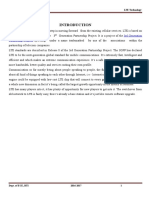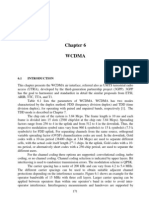LTE-A Well-Designed Mobile OFDMA IP Solution: Qualcomm Incorporated January 2008
LTE-A Well-Designed Mobile OFDMA IP Solution: Qualcomm Incorporated January 2008
Uploaded by
Mohamed AbdelhadyCopyright:
Available Formats
LTE-A Well-Designed Mobile OFDMA IP Solution: Qualcomm Incorporated January 2008
LTE-A Well-Designed Mobile OFDMA IP Solution: Qualcomm Incorporated January 2008
Uploaded by
Mohamed AbdelhadyOriginal Title
Copyright
Available Formats
Share this document
Did you find this document useful?
Is this content inappropriate?
Copyright:
Available Formats
LTE-A Well-Designed Mobile OFDMA IP Solution: Qualcomm Incorporated January 2008
LTE-A Well-Designed Mobile OFDMA IP Solution: Qualcomm Incorporated January 2008
Uploaded by
Mohamed AbdelhadyCopyright:
Available Formats
LTEA Well-Designed Mobile OFDMA IP Solution
Qualcomm Incorporated January 2008
LTEA Well-Designed Mobile OFDMA IP Solution
Table of Contents
[1] Executive Summary ......................................................................... 1 [2] Converging Markets ........................................................................ 2 2.1 LTE Addresses a Wide Range of Market Segments .............. 2 2.2 LTE Leverages Multimode Devices ........................................ 3 [3] LTE Leverages New and Wider Spectrum ...................................... 4 [4] LTE Complements HSPA ................................................................ 4 [5] LTE Performance and Key Features ............................................... 6 [6] Conclusion ....................................................................................... 8
1/2008
page i
LTEA Well-Designed Mobile OFDMA IP Solution
[1] Executive Summary
UMTS operators around the world are experiencing tremendous success with High-Speed Packet Access (HSPA), and are rapidly launching services to capitalize on HSPAs mobile-broadband capabilities and increased data capacity. 3GPP is currently defining Long Term Evolution (LTE), which allows UMTS operators to build on HSPAs success and complement HSPA with even higher peak rates and lower latency, thus supporting an enhanced broadband experience in high-demand areas, while leveraging new and wider spectrum. The industry is rapidly moving toward the convergence of communication, computing and consumer platforms, as well as converged services across fixed and wireless networks. Users desire services like voice, music, picture and video sharing, and social networkinganytime and anywhere, with a similar experience regardless of location. Mobile broadband is in the center of convergence, enabling consumer and corporate users to enjoy higher data rates and a broadband experience in all environments, using converged devices. LTE will support a variety of devices, including desktop modems, mobile phones, laptops and ultra-mobile PCs (UMPCs), and will effectively meet the demand for connectivity from a new generation of consumer electronics devices with embedded modems. LTE allows operators to economically and effectively address all market segments and offer innovative services. LTE is a leading OFDMA-based, mobile broadband technology, supported by a new core network being developed by 3GPP. LTE has been designed to provide interoperability and service continuity with existing UMTS networks, allowing UMTS operators to capitalize on existing UMTS/HSPA and future HSPA+ investments. It offers high spectral efficiency, low latency and high peak data rates (277 Mbps downlink, 75 Mbps uplink in 20 MHz) and leverages HSPA/LTE multimode devices. LTE incorporates the most advanced techniques of OFDMA and antenna techniques such as MIMO (Multiple-Input Multiple-Output), SDMA (Spatial Division Multiple Access) and beamforming, among others.
1/2008
page 1
LTEA Well-Designed Mobile OFDMA IP Solution
[2] Converging Markets
As the trend toward convergence accelerates, individuals increasingly expect to have access to services anywhere and anytimeaccess to voice, broadband Internet, email, portable music, picture sharing and live video sharing. In addition, user-generated content and social networking open an array of possibilities in a mobile world. Many of these services have already been made available through todays 3G networks, and demand for these services will continue to grow. LTEs flexible air interface with integrated Quality of Service (QoS) and low latency will support the entire range of IP services, including delay-sensitive services such as telco-quality VoIP. LTE will benefit users by enriching mobile communications and enhancing broadband applications through higher peak and average data rates. For fixed and nomadic applications, users will experience wireline-like speed and performance, similar to DSL and cable connections, over a wireless connection. For operators, QoS support enables service tiering, which allows the network to assign users different levels of priority based on subscription levels tailored to each users needs.
2.1 LTE Addresses a Wide Range of Market Segments
Consumers will enjoy LTEs broadband functionality in a variety of consumer electronic devices as well as phones, PDAs, UMPCs and laptops with embedded LTE modems or PC cards. As has already occurred in many HSPA markets, consumers may consider LTE as a replacement for their primary residential fixed broadband connection, thanks to its higher bandwidths and lower delays. A variety of devices, from gaming and portable entertainment players to pocket computers and beyond, can leverage the broadbandcommunication capabilities of LTE. The fast response times satisfy the needs of the most demanding users, such as gamers who require low-latency networks for interactive, real-time gaming.
1/2008
page 2
LTEA Well-Designed Mobile OFDMA IP Solution
Ubiquitous mobile broadband connectivity via LTE and HSPA+ will also act as a catalyst for future innovation in devices. Consumers will increasingly demand that devices and services enabled today by Wi-Fi provide wide-area broadband coverage, through HSPA today and LTE tomorrow. Corporate users will be able to obtain Ethernet-class performance through LTE, and mobile operators can configure their networks to satisfy the more stringent requirements of corporate users, such as higher-priority performance and response time. Corporate users will enjoy LTE services by using PC cards or embedded modems in devices such as PDAs, UMPCs or laptops, in addition to mobile phones. Multimode LTE and HSPA+ devices will ensure a similar user experience and ubiquitous coverage, regardless of the users location. As with consumer users, corporate users will increasingly consider LTE as a primary broadband replacement for their business landlines, thanks to the higher bandwidths, lower delays and high capacity provided by LTE.
2.2 LTE Leverages Multimode Devices
One important factor driving the cost of a wireless technology is the ecosystem of infrastructure and device vendors. LTE leverages multimode devices that are backward compatible with existing 3G technologies. It relies on a proven industry business model for faster time to market with innovative services and robust mobile-broadband systems. Multimode devices allow operators to deploy LTE networks in phases, thus minimizing initial investments and focusing LTE on high-demand areas. Users can fall back on existing 3G networks in areas outside the LTE coverage.
1/2008
page 3
LTEA Well-Designed Mobile OFDMA IP Solution
[3] LTE Leverages New and Wider Spectrum
LTE leverages new and wider spectrum, complementing HSPA and HSPA+ deployments by providing a capacity boost in high-demand areas. LTEs OFDMA technology provides increasingly higher capacity at wider bandwidths. From a performance perspective, LTE is therefore best suited for bandwidths of 10 to 20 MHz, leveraging the benefits of OFDMA. Similarly, LTE is less suited for bandwidths below 5 MHz; HSPA+ provides similar capacity and peak rates as LTE in the 5 MHz block, for the same number of antennas.
LTE Allows Flexible Spectrum Usage
HSPA+ & LTE in 5MHz Provides Similar Performance
LTE for Wider Bandwidths Complementing HSPA+
1.25 MHz*
2.5 MHz*
5 MHz
10 MHz
15 MHz
20 MHz
Better Performance for Wider Bandwidths
Figure 1: LTE Leverages Wider Bandwidths
LTE flexibly supports a range of bandwidths up to 20 MHz, as depicted in Figure 1. The available peak rate and average user rate per individual user scales directly with the bandwidth. LTE supports both frequency division duplex (FDD) and time division duplex (TDD) modes, allowing operators to address all available spectrum types.
[4] LTE Complements HSPA
UMTS operators around the world are experiencing a tremendous success with HSPA and are rapidly launching services to capitalize on HSPAs mobile broadband capabilities and increased data capacity. HSPA+ further enhances the performance capabilities through incremental investments and backward-compatible devices. HSPA+ will ensure a consistent user experience across the entire network, and it allows the operator to roll out LTE in phases, such that LTE
1/2008 page 4
LTEA Well-Designed Mobile OFDMA IP Solution
is first deployed in dense urban areas and then gradually expanded. The common IMS network enables users to experience the same services across the entire network, regardless of airlink technology. HSPA+ offers similar capacity and peak rates as LTE in the 5 MHz block, and provides a similar user experience and service continuity outside the LTE coverage. LTE enables even higher peak rates and average rates through 4x4 MIMO, using four receive and transmit antennas at both the Node B and user device. Furthermore, HSPA+ supports highcapacity VoIP, allowing voice-service continuity for LTE systems that rely on VoIP. LTE uses a new core network called Enhanced Packet Core (EPC), which allows for a more flat and IP-based architecture. Throughout the design of LTE and EPC, emphasis is placed on ensuring interoperability with existing 3GPP technologies like UMTS and GSM. This will ensure that HSPA+ and LTE coexist. The emphasis on EPC is also to reduce network latency and simplify network operation and maintenance.
HSPA/HSPA+ LTE LTE LTE
Figure 2: LTE Overlay on a 3G Network
As shown in Figure 2, an operator can initially focus on high-demand areas, falling back to HSPA/HSPA+ outside the LTE coverage, and then continue the network build-out in phases, as data demand increases. Multimode devices supporting both LTE and the existing 3GPP technologies will enable backward compatibility outside the LTE coverage. The LTE network supports seamless handoffs to UMTS/HSPA networks, providing seamless service continuity throughout the complete UMTS network.
1/2008
page 5
LTEA Well-Designed Mobile OFDMA IP Solution
[5] LTE Performance and Key Features
LTE was designed from the ground up for mobility and high capacity, as well as for efficient delivery of real-time applications such as voice through VoIP. Supporting any mix of voice with data services on the same carrier allows the operator to meet all possible service needs and market segments. LTE leverages advanced antenna techniques such as MIMO, SDMA and beamforming, which provide benefits to users in both high and low signal-strength areas. Compared to HSPA+, LTE introduces higher-order downlink MIMO (up to 4x4 MIMO) and MIMO in the uplink, to further increase the peak rates and performance. All of these techniques aim to increase the data rates experienced by the user, as well as the capacity of the system.
LTE Peak Data Rates
Downlink
10 MHz
(4x4 MIMO)
20 MHz
(4x4 MIMO)
138 Mbps
277 Mbps
Uplink
37 Mbps
75 Mbps
Table 1: LTE Data Rate for 10 MHz and 20 MHz FDD
As shown in Table 1, the LTE peak data rates increases with the available bandwidths, and can be as high as 277 Mbps in the downlink, for a single user in ideal radio conditions using 4x4 MIMO in 20 MHz. MIMO can increase the system capacity and the user data rates without using additional power or bandwidth, by transmitting multiple streams through multiple antennas at the receiver and transmitter. MIMO allows very high data rates, especially for users close to the base station,
1/2008
page 6
LTEA Well-Designed Mobile OFDMA IP Solution
whenever it is possible to transmit multiple orthogonal streams. A rich scattering environment is required to ensure that the multiple data streams remain orthogonal. The MIMO benefit is therefore maximized in a dense urban (city) environment, as there is enough scattering, and for users close to the eNode B.
Downlink Data Capacity Per Sector (10 MHz FDD)
25.71 20.43 15.62 12.36 6.88 16.2
R6 HSPA Basline (RxDiv+RAKE)
R6 HSPA (RxDiv+EQ)
R7 HSPA+ (2x2 MIMO)
LTE 2x2 MU-MIMO
LTE 1x4 SIMO
LTE 4x4 MU-MIMO
Figure 3: Higher Sector Capacity Lowers Cost per Bit 1
Beamforming increases the user data rates by focusing the transmit power in the direction of the user, effectively increasing the signal at the user. Beamforming provides the most benefits to the users in areas with weaker signal strength, like the edge of the cell coverage. SDMA is another advanced technique, which increases sector capacity by allowing simultaneous transmissions of the same physical resources to different users, who are spatially separated. This technique can be combined with MIMO to offer higher data rates simultaneously. Figure 3 presents the LTE downlink data capacity for 10 MHz FDD and a smaller cell, illustrating the benefit of advanced antenna techniques and the increasing performance with higher-order MIMO. Using the same number of antennas and MIMO, both HSPA+ and LTE provide similar performance.
Source: Qualcomm simulations, D1: 500m ISD, HSPA+ scaled up from 5 MHz, details in 3GPP R1-070674.
1/2008
page 7
LTEA Well-Designed Mobile OFDMA IP Solution
[6] Conclusion
LTE is a highly optimized, spectrally efficient, mobile OFDMA solution built from the ground up for mobility, and it allows operators to offer advanced services and higher performance for new and wider bandwidths. LTE builds on HSPAs success and will complement existing HSPA and HSPA+ networks with a capacity boost in highdemand areas. LTEs high performance, integrated QoS support and low latency allow operators to efficiently target the entire range of IP services, from delay-sensitive services such as telco-quality VoIP to HD-quality video streaming. LTE will support the full range of devices including desktop modems, mobile phones, laptops, and ultra-mobile PCs, and will effectively meet the demand for connectivity from a new generation of consumer electronics devices. LTE allows operators to economically address all market segments and many types of innovative services, including the stringent needs of corporate clients with high-bandwidth demands. LTE is based on a flattened IP-based network architecture that improves network latency, and is designed to interoperate on and ensure service continuity with existing 3GPP networks. LTE leverages the benefits of existing 3G technologies and enhances them further with additional antenna techniques such as higher-order MIMO. The 3G ecosystem of device manufacturers will leverage 3G knowledge and experience to ensure availability of multimode devices to suit a variety of applications and end-user preferences in the years ahead.
2007 Qualcomm Incorporated. All rights reserved. Qualcomm asserts that all information is correct through January 2008.
1/2008
page 8
You might also like
- Concise Guide to OTN optical transport networksFrom EverandConcise Guide to OTN optical transport networksRating: 4 out of 5 stars4/5 (2)
- Product Visio Icon0900aecd800940d9Document264 pagesProduct Visio Icon0900aecd800940d9Fede VarelaNo ratings yet
- UMTS To LTE Migration White PaperDocument18 pagesUMTS To LTE Migration White PaperMaria LunaNo ratings yet
- LTE Signaling: Troubleshooting and OptimizationFrom EverandLTE Signaling: Troubleshooting and OptimizationRating: 3.5 out of 5 stars3.5/5 (2)
- CAD Finesse DifferenceDocument2 pagesCAD Finesse DifferencehclwmganandNo ratings yet
- Barracuda Web Application Firewall Best Practices Guide PDFDocument14 pagesBarracuda Web Application Firewall Best Practices Guide PDFbas6677No ratings yet
- Qualcomm - LTE White PaperDocument10 pagesQualcomm - LTE White PaperyannbruxellesNo ratings yet
- 3GPP Long-Term Evolution (LTE) : Qualcomm Incorporated January 2008Document19 pages3GPP Long-Term Evolution (LTE) : Qualcomm Incorporated January 2008badri1969revanthNo ratings yet
- LTE, The Way To The Future: Huawei Technologies Co., LTDDocument16 pagesLTE, The Way To The Future: Huawei Technologies Co., LTDRandy Dookheran0% (1)
- LTE - HuaweiDocument16 pagesLTE - HuaweiAman DuttaNo ratings yet
- Long Term Evolution LTE EbookDocument44 pagesLong Term Evolution LTE EbookMahinda Saman BandaraNo ratings yet
- Towards Global Mobile Broadband 1. Introduction: What Is LTE?Document8 pagesTowards Global Mobile Broadband 1. Introduction: What Is LTE?Kinjalkumar M. GarasiyaNo ratings yet
- 3g To 4g Migration - ArticleDocument3 pages3g To 4g Migration - ArticleRajesh PorwalNo ratings yet
- Longterm EvolutionDocument11 pagesLongterm EvolutionAbdenour BentaharNo ratings yet
- Lte OverviewDocument3 pagesLte Overviewrahulyadav243No ratings yet
- LTE OverviewDocument3 pagesLTE OverviewVishwaNo ratings yet
- Long Term Evolutio1 MaterialDocument7 pagesLong Term Evolutio1 MaterialPriyanshu KumarNo ratings yet
- Evolution of LTE (4G)Document4 pagesEvolution of LTE (4G)Harsh GuptaNo ratings yet
- LTE Overview Ericsson PDFDocument16 pagesLTE Overview Ericsson PDFDondieReturan100% (2)
- LTE - When The Time's Right: Northstream White PaperDocument7 pagesLTE - When The Time's Right: Northstream White PaperOon CKNo ratings yet
- Capesso Symena LTE Network DesignDocument18 pagesCapesso Symena LTE Network Designhaidine_DDBonnNo ratings yet
- Gsa Evolution To Lte Report 121011.Php4Document26 pagesGsa Evolution To Lte Report 121011.Php4zahidtgNo ratings yet
- UMTS Forum Towards Global Mobile Broadband LTE White PaperDocument12 pagesUMTS Forum Towards Global Mobile Broadband LTE White PaperAmit ChakradeoNo ratings yet
- Long-Term Evolution (LTE) : The Vision Beyond 3G: White PaperDocument6 pagesLong-Term Evolution (LTE) : The Vision Beyond 3G: White PaperSenthilathiban ThevarasaNo ratings yet
- Case Study: LTE Network Design Using Capesso™Document17 pagesCase Study: LTE Network Design Using Capesso™leonardo_wcdmaNo ratings yet
- Prepared By: Ms. Priti RumaoDocument56 pagesPrepared By: Ms. Priti RumaoPriti RumaoNo ratings yet
- Arm DesigningDocument13 pagesArm DesigningNeo MechatronNo ratings yet
- Nokia Td-Lte Fact SheetDocument12 pagesNokia Td-Lte Fact SheetVulpe FlorianNo ratings yet
- Beyond 3G: An Extract From 3GPPDocument13 pagesBeyond 3G: An Extract From 3GPPVikram KolanuNo ratings yet
- LTE White Paper 2.09Document6 pagesLTE White Paper 2.09tariktarikovNo ratings yet
- Symena LTE Network Design Using Capesso LTE ADocument18 pagesSymena LTE Network Design Using Capesso LTE ALTE_simulatorNo ratings yet
- LTE The Mobile Broadband FutureDocument14 pagesLTE The Mobile Broadband FutureNeeraj kumarNo ratings yet
- Get Ready 4 LTEDocument2 pagesGet Ready 4 LTESandeep KadamNo ratings yet
- ARM-CEVA LTE-Advanced White Paper FinalDocument13 pagesARM-CEVA LTE-Advanced White Paper Finalgame___overNo ratings yet
- Long Term Evolution: D.A.C.H Dandeniya ET/07/6853Document9 pagesLong Term Evolution: D.A.C.H Dandeniya ET/07/6853Tharindu MadushankaNo ratings yet
- Market Outlook For LTEDocument7 pagesMarket Outlook For LTEfarrukhmohammedNo ratings yet
- LTE White Paper April 2009Document7 pagesLTE White Paper April 2009stephanus andyNo ratings yet
- Nokia Siemens Networks Td-Lte Fact SheetDocument8 pagesNokia Siemens Networks Td-Lte Fact Sheetnm7713No ratings yet
- LTE: Long Ter M EvolutionDocument3 pagesLTE: Long Ter M EvolutionBijay DeepNo ratings yet
- Unit 6 LTE & 5GDocument6 pagesUnit 6 LTE & 5Gamey vermaNo ratings yet
- LTEDocument2 pagesLTENishaNo ratings yet
- LTE Benefits GuideDocument9 pagesLTE Benefits GuidedinamostafamohamedNo ratings yet
- 3rd Generation Partnership Project: LTE TechnologyDocument21 pages3rd Generation Partnership Project: LTE TechnologypunithNo ratings yet
- Isn't It Time: For Your Network To Evolve?Document2 pagesIsn't It Time: For Your Network To Evolve?rrakeshgNo ratings yet
- Simplifying The Migration To 4G Networks: White PaperDocument8 pagesSimplifying The Migration To 4G Networks: White PaperRahul GuptaNo ratings yet
- The Second Phase of LTE-Advanced LTE-B 30-Fold Capacity Boosting To LTEDocument20 pagesThe Second Phase of LTE-Advanced LTE-B 30-Fold Capacity Boosting To LTERenegades182No ratings yet
- LTE TDD WP Phase1 v3Document14 pagesLTE TDD WP Phase1 v3Anovar_ebooksNo ratings yet
- LTE Seminar ReportDocument22 pagesLTE Seminar ReportpunithNo ratings yet
- NSN Lte-Advanced White PaperDocument20 pagesNSN Lte-Advanced White Paperjoseph221106No ratings yet
- Why Is LTE Essential?: Operators' Challenges A Framework For Strategy DevelopmentDocument24 pagesWhy Is LTE Essential?: Operators' Challenges A Framework For Strategy DevelopmentOsama El MesalawyNo ratings yet
- New Microsoft Office Word DocumentDocument26 pagesNew Microsoft Office Word Documentakhilmadhu2010No ratings yet
- LTE - Network and ProtocolDocument16 pagesLTE - Network and ProtocolTechnical saadNo ratings yet
- Self-Organizing Networks: Self-Planning, Self-Optimization and Self-Healing for GSM, UMTS and LTEFrom EverandSelf-Organizing Networks: Self-Planning, Self-Optimization and Self-Healing for GSM, UMTS and LTEJuan RamiroNo ratings yet
- The 5G Revolution: How the Next Generation of Wireless Will Change EverythingFrom EverandThe 5G Revolution: How the Next Generation of Wireless Will Change EverythingNo ratings yet
- Modeling and Dimensioning of Mobile Wireless Networks: From GSM to LTEFrom EverandModeling and Dimensioning of Mobile Wireless Networks: From GSM to LTENo ratings yet
- LTE Self-Organising Networks (SON): Network Management Automation for Operational EfficiencyFrom EverandLTE Self-Organising Networks (SON): Network Management Automation for Operational EfficiencySeppo HämäläinenNo ratings yet
- 40mins Channel EMEA NSE Update Webinar April 2023Document41 pages40mins Channel EMEA NSE Update Webinar April 2023Mohamed AbdelhadyNo ratings yet
- F4aj8sfoysvu WhatsNew NGFW Admin 67Document12 pagesF4aj8sfoysvu WhatsNew NGFW Admin 67Mohamed AbdelhadyNo ratings yet
- d832tcs8stf2 WhatsNew NGFW 6.10Document16 pagesd832tcs8stf2 WhatsNew NGFW 6.10Mohamed AbdelhadyNo ratings yet
- pn84k6hzsp8f WhatsNew NGFW Admin 65Document19 pagespn84k6hzsp8f WhatsNew NGFW Admin 65Mohamed AbdelhadyNo ratings yet
- Ntyrgl3es7sv WhatsNew NGFW Admin 66Document15 pagesNtyrgl3es7sv WhatsNew NGFW Admin 66Mohamed AbdelhadyNo ratings yet
- Fortigate Infra 6.2 Lab GuideDocument143 pagesFortigate Infra 6.2 Lab GuideMohamed AbdelhadyNo ratings yet
- Huawei BTS3012 Product DescriptionDocument38 pagesHuawei BTS3012 Product DescriptionWaleed M. AbdullahNo ratings yet
- BSC TRAU High CapacityDocument4 pagesBSC TRAU High CapacityNyankoye Apollinaire LouaNo ratings yet
- WCDMA Channel ConceptDocument35 pagesWCDMA Channel ConceptrajivseprajNo ratings yet
- HD-R712 Specification V1.0Document5 pagesHD-R712 Specification V1.0quang nguyễnNo ratings yet
- SSP Smiley Secure Protocol: Intelligence in ValidationDocument90 pagesSSP Smiley Secure Protocol: Intelligence in ValidationDobNo ratings yet
- 03 RTU560 Introduction EDocument10 pages03 RTU560 Introduction EEdmund Stokes-WallerNo ratings yet
- MN Cdm625aDocument756 pagesMN Cdm625aMorhne Rufin100% (1)
- Tools: List of Equipment/ToolsDocument3 pagesTools: List of Equipment/ToolsGenesis Sto.domingoNo ratings yet
- Huawei S5700 Configuration Guide - MulticastDocument298 pagesHuawei S5700 Configuration Guide - MulticastSasidhar KesaniNo ratings yet
- Project44 Final PaperDocument22 pagesProject44 Final PaperPrachit BhandariNo ratings yet
- XPOL Panel k741518Document2 pagesXPOL Panel k741518Drazyck SlimaniNo ratings yet
- 2 Bounce 3 - 21Document45 pages2 Bounce 3 - 21gcampbell9765100% (1)
- Template - Agreement - For - ISP - VSAT - 1 (1) - 0Document48 pagesTemplate - Agreement - For - ISP - VSAT - 1 (1) - 0Rhem CayabNo ratings yet
- Examen 4 FirewallDocument21 pagesExamen 4 FirewallAponteTrujilloNo ratings yet
- Graylog Optimizing SIEM Log MGMT EbookDocument12 pagesGraylog Optimizing SIEM Log MGMT EbookJoe-smithNo ratings yet
- Band Plan For The Amateur Radio in BangladeshDocument52 pagesBand Plan For The Amateur Radio in Bangladeshs21swe5No ratings yet
- NCP-MCI 6.5 Flashcards - QuizletDocument52 pagesNCP-MCI 6.5 Flashcards - QuizletGopi ChandNo ratings yet
- FogComputingVsCloudComputing-MoonmoonChakraborty 5Document11 pagesFogComputingVsCloudComputing-MoonmoonChakraborty 5cheekuvditogetherNo ratings yet
- New Clarity Aloft Link ManualDocument12 pagesNew Clarity Aloft Link ManualVictor H FaucheretNo ratings yet
- Nokia Fhdi Product DescreptionDocument6 pagesNokia Fhdi Product DescreptionkrishkarnNo ratings yet
- Yealink CP965 DatasheetDocument3 pagesYealink CP965 DatasheetJavier BravoNo ratings yet
- Quick Installation Guide: Quick Setup Using The WPS (RE) ButtonDocument2 pagesQuick Installation Guide: Quick Setup Using The WPS (RE) ButtonShero KhanNo ratings yet
- Manually Configuring A Polycom SoundPoint IP 320, 321, 330, 331, 450, 550, 560, 650, 670 and SoundStation IP 6000, 7000 With 3CX Phone System For WindowsDocument2 pagesManually Configuring A Polycom SoundPoint IP 320, 321, 330, 331, 450, 550, 560, 650, 670 and SoundStation IP 6000, 7000 With 3CX Phone System For WindowsgrregwalzNo ratings yet
- PM1000II: Sound Quality. Sound EngineeringDocument9 pagesPM1000II: Sound Quality. Sound Engineeringsatyajit pawarNo ratings yet
- CCS Unit V Notes 2Document24 pagesCCS Unit V Notes 2Vasantha Kumar VNo ratings yet
- GoIP With SMPP SupportDocument3 pagesGoIP With SMPP SupportJonathan Edson LaraNo ratings yet
- AS-i 3.0 PROFIBUS Gateway With Integrated Safety MonitorDocument2 pagesAS-i 3.0 PROFIBUS Gateway With Integrated Safety MonitorHữu HàNo ratings yet
- Introduction To The Internet and WebDocument23 pagesIntroduction To The Internet and WebAmit SharmaNo ratings yet
- CP R75.20 Firewall Admin GuideDocument208 pagesCP R75.20 Firewall Admin GuideDixan777No ratings yet
- IR2206N UsersGuide UkEN 1Document617 pagesIR2206N UsersGuide UkEN 1shamsudin yassinNo ratings yet


































































































